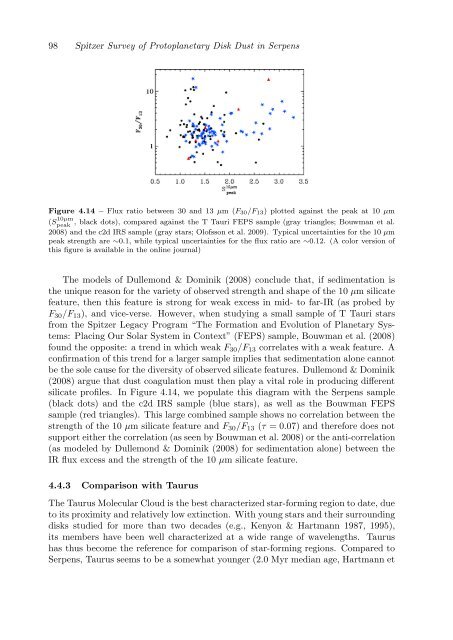Observational Constraints on The Evolution of Dust in ...
Observational Constraints on The Evolution of Dust in ...
Observational Constraints on The Evolution of Dust in ...
You also want an ePaper? Increase the reach of your titles
YUMPU automatically turns print PDFs into web optimized ePapers that Google loves.
98 Spitzer Survey <strong>of</strong> Protoplanetary Disk <strong>Dust</strong> <strong>in</strong> Serpens<br />
Figure 4.14 – Flux ratio between 30 and 13 µm (F 30 /F 13 ) plotted aga<strong>in</strong>st the peak at 10 µm<br />
(S 10µm<br />
peak , black dots), compared aga<strong>in</strong>st the T Tauri FEPS sample (gray triangles; Bouwman et al.<br />
2008) and the c2d IRS sample (gray stars; Ol<strong>of</strong>ss<strong>on</strong> et al. 2009). Typical uncerta<strong>in</strong>ties for the 10 µm<br />
peak strength are ∼0.1, while typical uncerta<strong>in</strong>ties for the flux ratio are ∼0.12. (A color versi<strong>on</strong> <strong>of</strong><br />
this figure is available <strong>in</strong> the <strong>on</strong>l<strong>in</strong>e journal)<br />
<strong>The</strong> models <strong>of</strong> Dullem<strong>on</strong>d & Dom<strong>in</strong>ik (2008) c<strong>on</strong>clude that, if sedimentati<strong>on</strong> is<br />
the unique reas<strong>on</strong> for the variety <strong>of</strong> observed strength and shape <strong>of</strong> the 10 µm silicate<br />
feature, then this feature is str<strong>on</strong>g for weak excess <strong>in</strong> mid- to far-IR (as probed by<br />
F 30 /F 13 ), and vice-verse. However, when study<strong>in</strong>g a small sample <strong>of</strong> T Tauri stars<br />
from the Spitzer Legacy Program “<strong>The</strong> Formati<strong>on</strong> and Evoluti<strong>on</strong> <strong>of</strong> Planetary Systems:<br />
Plac<strong>in</strong>g Our Solar System <strong>in</strong> C<strong>on</strong>text” (FEPS) sample, Bouwman et al. (2008)<br />
found the opposite: a trend <strong>in</strong> which weak F 30 /F 13 correlates with a weak feature. A<br />
c<strong>on</strong>firmati<strong>on</strong> <strong>of</strong> this trend for a larger sample implies that sedimentati<strong>on</strong> al<strong>on</strong>e cannot<br />
be the sole cause for the diversity <strong>of</strong> observed silicate features. Dullem<strong>on</strong>d & Dom<strong>in</strong>ik<br />
(2008) argue that dust coagulati<strong>on</strong> must then play a vital role <strong>in</strong> produc<strong>in</strong>g different<br />
silicate pr<strong>of</strong>iles. In Figure 4.14, we populate this diagram with the Serpens sample<br />
(black dots) and the c2d IRS sample (blue stars), as well as the Bouwman FEPS<br />
sample (red triangles). This large comb<strong>in</strong>ed sample shows no correlati<strong>on</strong> between the<br />
strength <strong>of</strong> the 10 µm silicate feature and F 30 /F 13 (τ = 0.07) and therefore does not<br />
support either the correlati<strong>on</strong> (as seen by Bouwman et al. 2008) or the anti-correlati<strong>on</strong><br />
(as modeled by Dullem<strong>on</strong>d & Dom<strong>in</strong>ik (2008) for sedimentati<strong>on</strong> al<strong>on</strong>e) between the<br />
IR flux excess and the strength <strong>of</strong> the 10 µm silicate feature.<br />
4.4.3 Comparis<strong>on</strong> with Taurus<br />
<strong>The</strong> Taurus Molecular Cloud is the best characterized star-form<strong>in</strong>g regi<strong>on</strong> to date, due<br />
to its proximity and relatively low ext<strong>in</strong>cti<strong>on</strong>. With young stars and their surround<strong>in</strong>g<br />
disks studied for more than two decades (e.g., Keny<strong>on</strong> & Hartmann 1987, 1995),<br />
its members have been well characterized at a wide range <strong>of</strong> wavelengths. Taurus<br />
has thus become the reference for comparis<strong>on</strong> <strong>of</strong> star-form<strong>in</strong>g regi<strong>on</strong>s. Compared to<br />
Serpens, Taurus seems to be a somewhat younger (2.0 Myr median age, Hartmann et
















